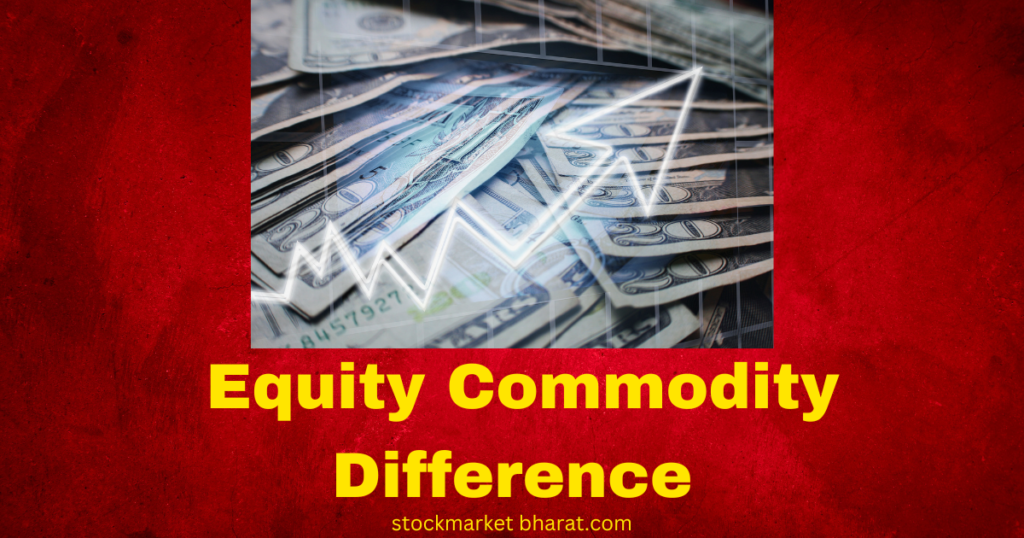Equity Commodity Difference
Understanding the Difference Between Equity and Commodity Markets
When it comes to investing in financial markets, two major asset classes that attract traders and investors are equities and commodities. Both offer opportunities for profit but operate in distinct markets with unique characteristics, risks, and potential rewards. Understanding the difference between equity and commodity is essential for making informed investment decisions.
In this blog, we will explore what equity and commodity markets are, their key features, benefits, and risks, and how they differ from each other. This will help you decide which one aligns better with your investment goals.

What is Equity?
Equity represents ownership in a company, typically in the form of stocks or shares. When you invest in equities, you become a partial owner of the company and gain a claim on its future profits. Equity trading takes place on stock exchanges such as the National Stock Exchange (NSE) and the Bombay Stock Exchange (BSE) in India.
Features of Equity:
- Ownership rights: Equity holders have partial ownership of the company and may receive dividends.
- Long-term growth: Equities offer the potential for capital appreciation over time.
- Liquidity: Stocks are highly liquid and can be easily bought or sold on exchanges.
- Risk and volatility: Equity prices fluctuate based on company performance, market sentiment, and economic factors.
Example of Equity Trading:
Suppose you purchase 100 shares of TCS at Rs. 3,500 per share. If the stock price rises to Rs. 3,800, you make a profit of Rs. 300 per share, resulting in a total gain of Rs. 30,000.
Advantages of Equity Investments:
- Wealth creation: Equities have historically delivered superior long-term returns.
- Dividend income: Some companies pay regular dividends, providing steady income.
- Inflation hedge: Equities generally outperform inflation over time.
Risks of Equity Investments:
- Market volatility: Share prices fluctuate frequently.
- Company risk: Poor financial performance of the company may reduce stock value.
- Economic impact: Broader market trends and economic downturns can affect equity prices.
What is Commodity?
Commodity refers to physical goods or raw materials that are traded in bulk. These include agricultural products, metals, energy resources, and livestock. Commodities are traded on dedicated exchanges such as the Multi Commodity Exchange (MCX) and the National Commodity and Derivatives Exchange (NCDEX) in India.
Types of Commodities:
- Metals: Gold, silver, copper, aluminum.
- Energy: Crude oil, natural gas, coal.
- Agricultural: Wheat, sugar, rice, cotton.
- Livestock: Cattle, hogs, and poultry.
Features of Commodity Trading:
- Physical goods: Commodities are tangible assets with real-world value.
- Futures contracts: Commodities are often traded through futures contracts, where buyers and sellers agree to a price for a future date.
- Inflation protection: Commodities often serve as a hedge against inflation.
- Global influence: Commodity prices are influenced by global supply and demand.
Example of Commodity Trading:
Suppose you buy 1 lot of crude oil futures at Rs. 5,500 per barrel. If the price rises to Rs. 5,800, you make a profit of Rs. 300 per barrel.
Advantages of Commodity Investments:
- Diversification: Commodities add variety to your portfolio, reducing overall risk.
- Inflation protection: Commodity prices tend to rise with inflation.
- Short-term profits: Commodity trading offers opportunities for short-term gains through futures contracts.
Risks of Commodity Investments:
- High volatility: Commodity prices fluctuate based on global factors, making them highly unpredictable.
- Leverage risk: Futures contracts involve leverage, which can amplify both gains and losses.
- Storage and transportation costs: Physical commodities involve logistics costs.
Key Differences Between Equity and Commodity
| Feature | Equity | Commodity |
|---|---|---|
| Asset Type | Ownership in a company | Physical goods or raw materials |
| Trading Platform | Stock exchanges (NSE, BSE) | Commodity exchanges (MCX, NCDEX) |
| Market Behavior | Driven by company performance, earnings | Driven by supply-demand dynamics |
| Liquidity | Highly liquid | Less liquid compared to equities |
| Volatility | Medium volatility | High volatility |
| Holding Period | Suitable for long-term holding | Often used for short-term trades |
| Returns Potential | High potential for long-term growth | Speculative short-term returns |
Equity vs. Commodity: Which One Should You Choose?
Choosing between equity and commodity depends on your financial goals, risk appetite, and trading preferences.
1. Choose Equity If:
- You aim for long-term wealth creation.
- You want to invest in fundamentally strong companies.
- You seek dividend income.
- You have a moderate risk tolerance and prefer liquidity.
2. Choose Commodity If:
- You want to diversify your portfolio with physical assets.
- You prefer short-term trading opportunities.
- You want to hedge against inflation and currency fluctuations.
- You have a higher risk tolerance and understand market volatility.
Trading Strategies for Equity and Commodity
1. Equity Trading Strategies:
- Buy and hold: Long-term investments in fundamentally strong stocks.
- Intraday trading: Buying and selling stocks within the same day.
- Swing trading: Holding stocks for a few days to capture short-term price movements.
2. Commodity Trading Strategies:
- Trend following: Trading based on market trends.
- Range trading: Buying near support levels and selling near resistance.
- Hedging: Using futures contracts to minimize potential losses.
ALSO READ: what-does-pe-and-ce-means
Conclusion
Both equity and commodity investments offer unique opportunities and come with their own set of risks. Equities are ideal for long-term wealth creation, while commodities provide short-term speculat